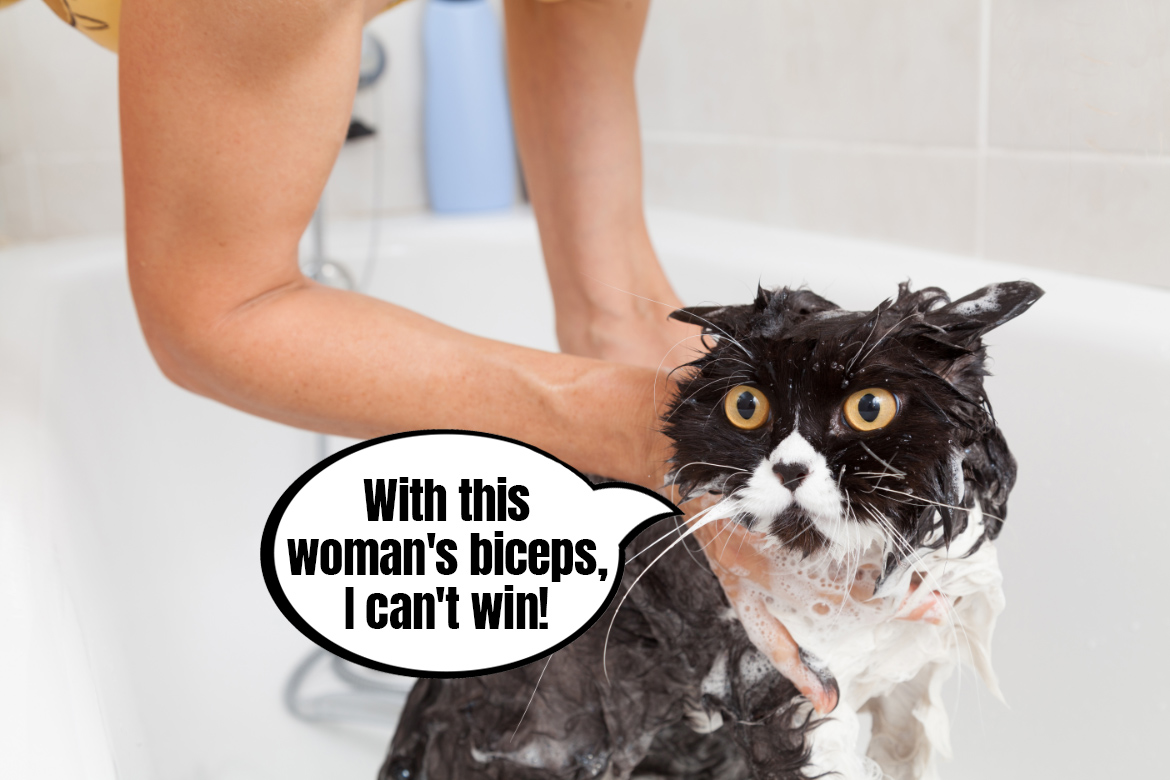What do cats do on the International Bath Day? They’re surely not waiting in a queue for the bathroom just to get into a blissfully relaxing bubble bath 🙂 We are sure that even if the bathtub was filled with catnip tea, it wouldn’t be attractive enough for cats to jump in, purely because of the water. But what is it exactly that makes cats dislike bath time, do they actually need them and how, in case it’s necessary, can we get through bathing a cat without any casualties? Today we’ll be talking about the biggest facts and myths about cat baths – join us, fabCats!
Cat baths – are they even necessary?
Cats are, by nature, very clean and they definitely don’t let us forget that – they can spend up to ⅓ of their day grooming their beautiful, lucious fur. And since nature gave them the best tool to do so – a rough tongue, cats can handle removing dirt from their hair on their own. What’s more, with few exceptions, most wild cats never had the need or wish to go in water. It’s no surprise then that domestic cats would rather lounge on the couch than bathe with their hoomans.
From the cat Guardians’ perspective, the issue is not that simple and within many facts and myths about bathing cats, we can find arguments that “cats should never be bathed”, as well as “I bathe my cats regularly and they’re fine”, or even “my cats jump into the bathtub on their own and they love it”. As always, truth lies somewhere in between. How is it possible? Here’s an explanation:
Fact: cats don’t need baths. They can take care of their fur all on their own, so in most cases baths are not necessary and oftentimes not that good for their luscious coats. Cat fur is covered with a special, slightly oily protective layer which provides warmth and protection from dirt, as well as keeps the skin in good condition. Baths remove the layer, which can not only make the hair condition worse, but also affect their sensitive skin.
Myth: cats should never be bathed. While it is a fact that cats don’t need baths, there are cases where a visit to the bathtub might be necessary. An example here would be hairless cats whose sensitive skin requires proper care (involving more than just regular baths). Cats can also fall into the shower when their fur is too dirty to be cleaned up with the cat’s tongue or if licking the fur might be dangerous for the feline – if they step in paint splattered on the floor, we definitely don’t want them to lick it off their paws.
When a cat might need a bath?
Among many reasons a cat might need to visit the bathtub or a shower, the most common are:
- Specific breed requirements – common especially with hairless cats,
- Stains that are difficult to remove and/or dangerous for cats. When a cat steps into a substance that’s potentially harmful for them, is difficult to remove or takes up too much surface for the cat to handle on their own (e.g. after a smelly accident in the litter box), a bath or quick wash may be necessary. Our team cat Teddy knows this scenario a little too well when he leaves the litter box with an unsatisfied grimace on his face and in no rush to take care of things by himself … 🙂
- Health conditions/worms. When a cat has worms (like giardia), most vets recommend not only disinfecting the entire house, but also to bathe the cat to avoid spreading the parasites when they groom themselves. A bath might be also necessary with some skin conditions.
- Disabilities. When a cat is not able to take care of their fur on their own, the weight of grooming their beautiful fur falls into the hands of us, their Carers.
- Aesthetics – it’s the most common reason for baths in catteries, when the cats are being prepared for shows and have to look their best to get the highest prize.
Are cats scared of water?
It’s definitely one of the most common myths regarding cat baths, which is why we want to look into it a little closer. It’s true that many cats are scared of water – in nature, among their wild ancestors as well, cats didn’t necessarily come by amounts of water that would give them a chance to bathe or require them to swim. Water is just for drinking 🙂 Cats can also be scared of water knowing that having wet fur is not the best idea – it gets heavy, can limit movement and slow them down, but it also takes a long time to get dry and doesn’t give the warmth that all cats love so much.
But wait – it’s not time to draw conclusions yet! Though it is true that cats are genetically predisposed to keep cautious around water and they’re not necessarily fans of diving, there are individuals who are happy to break the mold and not just tolerate water, but actually enjoy it. Tigers are one of these groups – water is a great place to have fun for them and swimming is one of the ways they use to move around their territories. As far as domestic cats go, there are breeds who are more likely to like water (like the turkish van), but in most cases it’s just a matter of individual preferences and we can observe a particular liking for water among persian cats, british shorthairs, scottish folds and street cats alike.
Myth: cats can’t swim
When we talk about cats and baths, the clear aversion cats have for water is often explained by them not being able to swim. And yes, among cats, just like among people, there are those who can’t swim and will never learn to do so. But it’s a myth that cats can’t swim at all – many cats are great swimmers and moving around in water isn’t that much of an obstacle for them.
The biggest fans of swimming are the aforementioned tigers and jaguars – the two wild cat species usually have no issues with water and thanks to their muscular bodies, they can move around in water quite quickly. Also, their fur is built in a way that protects their skin from too much moisture. Domestic cats, though they are slightly different from tigers or jaguars, actually have some similarities in how their bodies are built and they would manage to swim if the situation called for it. It’s an instinct they fortunately don’t have to test out in practice too often, so seeing them swim around in a garden pond to relax is a sight we can only dream about.
Fur and baths…? How to prepare to bathe a cat
Okay, fabCats – we know that the decision to bathe or not to bathe a cat is made based on a few factors. But how to deal with having to bathe a cat when it’s actually necessary and the cat doesn’t see it as the best way to relax? Preparation is key – not just for yourself, but for the cat and the space around you as well.
If you can, get your cat used to water. Even if you never need to bathe your cat, getting them used to water is a good practice all together. You can use your bathtub to play, throwing toys or snacks into an empty bathtub. In the summer it can also serve as a good way to cool down – put a small amount of water at the bottom (just so the cat feels it under their paws, but is not submerged too much) and invite them to try it out. Of course, don’t force anything here – we want the feline to only have good connotations with the bath.
Make it stress-free. Emergency situations where a bath may be needed are often a source of stress for both the cat and their Guardian. However, you can always try get the cat to the bath as relaxed as they can be – invite them to the shower when they’re just lounging around or after an intensive playtime, not when they’re ready to attack your ankles. During the bath, talk to your cat softly, petting them and making sure the bath is as quick as possible.
Take away their weapon. Sharp claws are the first line of defense for a cat, so if you have plans for a bath, try to trim them a day before to limit the risk of getting scratched and minimize the number of bathtime victims.
Give them a good brushout. If you have a long haired cat, think about brushing out their coat a day before a bath to remove any matted fur and knots – once they’re wet, it’s much harder to do so.
Use only bath products designed for cats. Because cats have such sensitive skin and different hair structure to hoomans, no products (even ones that are designed for kids) are good to use on shiny cat hair except ones designed specifically for cats.
The process of bathing itself should be as quick as possible. Fill the bath with warm, but not hot water, to a level where your cat will be able to stand with their paws in water (and not come into contact with it only when you spray it from the shower head). Get the entire body wet (without the head) and spread a watered-down shampoo – if you dilute it earlier in a container, it’s much easier to distribute the foam evenly and to wash it out of the fur. Once the bath is done, towel dry your cat (don’t rub, just let the towels soak in excess moisture) – if they’re not scared, you can use a hairdryer, but if it’s too traumatic, provide your kitty with a warm space they can air dry in.
At home or at the groomer’s?
To wrap it up, we’ll try to settle the need to visit the groomer’s with your cat. When it comes to cat Guardians, the opinions are varied – for some a professional groomer’s appointment is the best solution, as the person who’s trained to work with cats will give them the quickest and best care. Others, however, don’t feel like bathing their cats anywhere but at home because of the stress it may cause their pets to be in. In our opinion, dear fabCats, the decision is really up to you – we can’t say that visiting the groomer’s is always a good or always a bad decision. If you don’t feel confident in bathing your cat on your own, a professional groomer’s appointment might actually be better, provided they are trained to work with cats. On the other hand, if you know your cat is the typical scaredy cat and they panic when they meet strangers, even a quick at home bath will be better than paralyzing fear of being at the groomer’s.
How do your cats react to water, fabCats? Did they already score a visit to the bath, or maybe they are regualrs in your nearby groomer’s shop and allow themselves to get a full SPA treatment? jak na kontakt z wodą reagują Wasze koty, przeKoty? Czy zaliczyły już wizytę w wannie, a może regularnie odwiedzają kociego fryzjera i pozwalają sobie na pełną serię zabiegów w SPA? Be sure to let us know in the comments and share your best cat bath stories.




